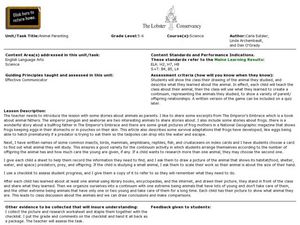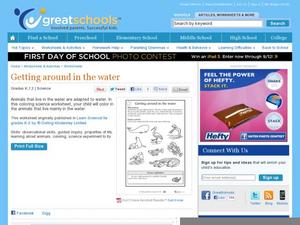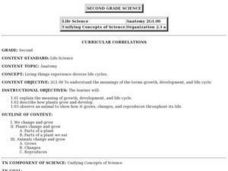Curated OER
Genetics with a Smile
In this genetics worksheet, students are given two coins that they mark with a "F" and a "M" to represent parents. They flip the coins to determine the genotype and phenotype of the offspring for twelve traits. They also use the coin to...
Curated OER
Pea Plants Dihybrid Cross
In this dihybrid cross learning exercise, students are given four crosses to complete using punnett squares. They determine the genotypic and phenotypic ratios of the offspring.
Curated OER
More Zork Genetics
In this genetics worksheet, learners complete 3 dihybrid crosses of traits to determine the probability of the genotypes and phenotypes of the offspring of the imaginary species, the Zork.
Curated OER
Zork Genetics
In this genetics worksheet, students use an imaginary species and a list of genetic traits and the alleles that code for each trait to determine the genotype and phenotype probabilities of offspring. Students complete nine monohybrid...
Curated OER
What is Genetics?
In this biology instructional activity, 9th graders name two forms of the trait for seed shape observed by Mendel. Then they determine the percentage of the possible types of offspring that have the same genotype as the parents. Students...
Curated OER
Farm Babies
Students use flash cards to match the mother names to the baby names for farm animals. In a designated "barn" in the room, students simulate being mothers, fathers, and babies. The baby must find his mother and father. Students visit...
Curated OER
Punnett Squares
Fifth graders examine how traits are passed to their offspring using Punnett Squares. They demonstrate how a Punnett Square works by physically moving around boxes taped on the floor, representing the different traits of chicks and...
Curated OER
Our Solar System
Third graders describe the composition of our solar system. They recognize the names of the planets in our solar system and compare and contrast the nine planets that orbit the sun.
Curated OER
Animals and Environments
Students listen to stories and identify animals and their young. In this animals lesson, students view videos about farm animals and create illustrations to show how animal babies change over time. Students discuss how they care for...
Curated OER
Dad's Magnetic Personality
Learners create a gift honoring Father's Day. In this Father's Day lesson, students examine the meaning of fatherhood and explore the history of this tradition. Learners create a picture collage over a template of their father's initials.
Curated OER
ESL: People Vocabulary
In this ESL vocabulary learning exercise, students match names of people with brief descriptions. A reference web site is given for additional resources.
Curated OER
Genetics Practice 3: Probability Practice
Practice calculating genetic probability, listing gametes, and identifying genotypes. The worksheet combines short answer questions with practice problems to solve. It would make a revealing review assignment or even a practical pop quiz...
Curated OER
Blood Typing Investigation
Young scholars role-play a scenario in which a car crash patient is inadvertently given the wrong blood type during a transfusion. They perform blood typing and explore the genetics behind ABO and RH blood types using simulated blood.
Curated OER
Turtle Shell Craft
Have your class learn about turtles and adaptation using this lesson. Learners discuss turtles, the unique design of their shells, and the ways they have adapted to their surroundings. Then, they make a paper bag model to simulate a...
Curated OER
Animal Parenting
Students analyze parenting instincts. In this parenting instincts lesson, students view a drawing of animal they studies and describe what they learned about the animal. Students teach the class about their animal and the class creates a...
Curated OER
My Arkansas Family Tree
Here is a two-part lesson that introduces learners to genealogy by having them create family trees, and map the movements of their ancestors. While this resource is designed for kids who live in Arkansas, it certainly can be adapted for...
Curated OER
Drugs Can Be Good and Bad
How can you tell which drugs are helpful, and which drugs are harmful? Use a health learning exercise in your kindergarten class to determine which drugs can make you healthy. They choose from a group of pictures that includes cough...
Curated OER
Animals and Humans
Students identify the functions of various body parts. They participate in the "Head, Shoulders, Knees, and Toes" song, draw a picture of themselves and other mammals, and create a traced outline of their body that they add features to....
Curated OER
Friends on the Farm
Young farmers explore the world of farm animals. They are introduced to a variety of animals, what their role is, how many legs they have, and what sounds they make. Worksheets and websites embedded in the plan are used to carry it out....
Curated OER
Genetics - The Study of Inheritance
For this genetics worksheet, students will compare four pea plants with different alleles that control flower color and complete 5 short answer questions. Then students will read 8 statements about genetic mutations and determine if the...
Curated OER
Getting Around in the Water
Young scientists who are learning about the variety of environments that animals live in use a activity in order to choose animals that live, primarily, in water environments. There are eight pictures on the activity, and learners must...
Curated OER
"The Party"
Students are introduced to the world of drama and explore and discuss the prospect of being an "outsider." They are encouraged to look into another person's experiences with drama. Each group of students act out short scenes to be...
Curated OER
Dinosaurs
Students are introduced to the various types of dinosaurs and write in their journals about their favorite one. After listening to a story and watching a filmstrip, they color a few pages in their Dinosaur Friends Book. They also examine...
Curated OER
Living Things Experience Diverse Life Cycles
Second graders will study and explain the meaning of growth, development, and life cycle. They describe how plants grow and develop and observe an animal to show how it grows, changes, and reproduces throughout its life.

























